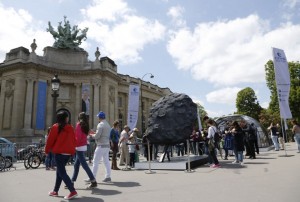Philae’s comet may host alien ‘life’–astronomers

People look at the comet “Tchouri” and Philae robot replicas displayed near the Grand palais in Paris on May 10, 2015, by the French National Centre for Space Studies (CNES). Astronomers proposed a novel explanation Monday, July 6, for the strange appearance of the comet carrying Europe’s robot probe Philae through outer space: alien microscopic life. AFP PHOTO/THOMAS SAMSON
PARIS–Astronomers proposed a novel explanation Monday for the strange appearance of the comet carrying Europe’s robot probe Philae through outer space: alien microscopic life.
Many of the frozen dust ball’s features, which include a black crust over lakes of ice, flat-bottomed craters and mega-boulders scattered on the surface, were “consistent” with the presence of microbes, they said.
Observations by the European Space Agency’s Rosetta comet orbiter has shown that 67P/Churyumov-Gerasimenko “is not to be seen as a deep-frozen inactive body, but supports geological processes,” Max Wallis of the University of Cardiff said in a statement issued by the Royal Astronomical Society (RAS).
In fact, the comet racing toward the Sun at a speed of 32.9 kilometers (20.4 miles) per second, “could be more hospitable to micro-life than our Arctic and Antarctic regions.”
Wallis and his colleague Chandra Wickramasinghe of the Buckingham Centre for Astrobiology, presented their theory Monday to a meeting of the RAS in Llandudno, Wales.
They pointed to Rosetta’s detection of complex organic material, which gave the comet its surprisingly super-dark and low-reflecting surface, as “evidence for life.”
Furthermore, Wickramasinghe told AFP that 67P’s gas ejections started “at distances from the Sun too far away to trigger surface sublimation.”
This implied that micro-organisms under the comet’s surface had been “building pockets of high pressure gases that crack overlying ice and vent organic particles,” he said by e-mail.
Wickramasinghe also cited a rugged surface with evidence of re-sealed cracks and displaced boulders, and a covering of organics which “need to be resupplied.”
The observed features “are all consistent with a mixture of ice and organic material that consolidate under the Sun’s warming during the comet’s orbiting in space, when active micro-organisms can be supported,” said the statement.
Micro-organisms could use liquid water to colonize the comet–infiltrating cracks in the ice and “snow” during warmer periods when the cosmic wanderer is nearer the Sun, the duo said.
“Organisms containing anti-freeze salts are particularly good at adapting to these conditions and some could be active at temperatures as low as minus 40 degrees Celsius (minus 40 degrees Fahrenheit).”
Sunlit areas of the comet already approached this temperature last September, when it was about 500 million kilometer (310 million miles) from the Sun, and emitting weak jets of gas.
Comets follow elliptical orbits around the Sun, and warm as they draw closer, causing a process of solid-to-gas transformation called sublimation, which is what gives them their spectacular tails.
As 67P approaches its closest point to the Sun, about 185 million km on August 13, “the micro-organisms should become increasingly active,” the pair speculated.
And hopefully Rosetta and Philae will catch some of the action live.
Comets are frozen balls of dust and ice left over from the Solar System’s formation some 4.6 billion years ago, and scientists hope that unravelling their makeup may provide insights into Earth’s own creation.
One theory is that they smashed into our infant planet, providing it with precious water and the chemical building blocks for life.